Waterbirds of Australia
Australia is not only the world’s driest continent (apart from Antarctica, where most of the wear is frozen) but also has the most unpredictable rainfall. Most of our waterbirds are therefore nomadic, moving as they need to find new water bodies as the water and/or food dries up in the ones they are occupying
Magpie Goose
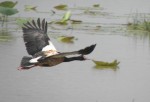
Magpie goose, Kakadu: photo Araucaria Ecotours
This large bird is related to the ducks, geese and swans but is sufficiently different to have a family of its own, with a distinctive head shape and trachea. They often appear rather muddy after fossicking for the plants they eat, roots and all, in swampy country.
They are found mostly in northern Australia and New Guinea, often in large flocks, but also in some subtropical wetlands. They were once more common in southern wetlands, but used to be hunted extensively.
Their evolutionary line is thought to have diverged from the ducks, geese and swans very early on, in the Cretaceous period.
Ducks and Swans
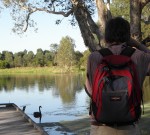
Photographing black swan: photo courtesy of Araucaria Ecotours
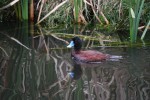
Blue-billed Duck:photo Gondwana Guides
There are many species of duck in Australia, the most common being the Pacific black duck, the wood duck (formerly maned goose) and grey teal.
The black swan confused the first explorers in Australia, making it suddenly obvious that no, not all swans are white, and some seem to have felt quite uncomfortable with this.
The Cape Barren Goose (not a true goose) of southern costs and islands was once considered threatened but has made an excellent come-back after the contra of hunting several decades ago.
Herons, Spoonbills, Bitterns and Storks

Black-necked stork: photo Araucaria Ecotours
Australia’s stork, the black-necked stork, used to be known as a jabiru, until it was realised this name is more correctly applied to a SouthAmerican species. It towers above most other waterbirds in wetlands, and is most commonly seen in the northern half of the continent.
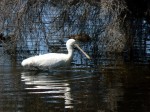
Yellow-billed Spoonbill: photo Gondwana Guides
The Australian white ibis is seen almost everywhere, including cities, the straw-necked ibis also very common in farmlands and some towns, but the glossy ibis, which doesn’t travel in flocks the way the others do, is seen less often, quietly feeding singly or in pairs in mud or shallow water.
Two spoonbills – the royal and the yellow-billed – are native to Australia in permanent wetlands and also in temporarily-flooded cattle paddocks and other grasslands (as are herons and some other waterbirds).
The white-faced and white-necked herons are the two most commonly-sighted heron, and there are a number of other heron and egret species.
Bitterns, being nocturnal and well-camiuflaged, are not often seen.
Waders.
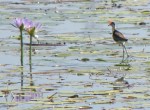
Jacana and waterlilies: photo Araucaria Ecotours
See also Seabirds of Australia
Many waders are found in our swamplands and around the edges of lakes and dams
The comb-crested jacana may often be seen walking over waterlily leaves.
Dotterels are very common – small brown birds running along mudflats or the edges of lakes and swamps, from coast to outback.
Avocets, sandpipers, snipes and other waders may be seen at many wetland areas
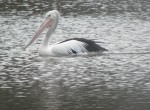
Pelican at Eagleby Wetlands: photo Araucaria Ecotours
Pelicans, cormorants and darters.
The Australian pelican can appear at any large dam, lake, river or estuary in Australia, often accompanied by one or more cormorant species, and darters are also a common sight.
All species will often be seen sitting with wings spread out to dry in the wind and sun after a plunge in the water.
Pelican feeding is a feature of various holiday resorts, and they may also be viewed in a number of zoos and wildlife parks.
Cranes, crakes, coots and relatives
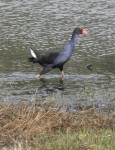
Purple swamp-hen: photo Araucaria Ecotours
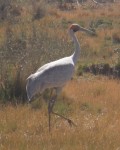
Brolga in Queensland outback: photo Araucaria Ecotours
Australia’s crane, the brolga, is most frequently seen in the northern half of the continent, though its distribution does extend to Victoria. It is usually seen in grassland near water. A second crane species, the sarus crane, which occurs through tropical Asia, also inhabit the far north, and is very similar to the brolga except for extra red on the head and upper neck.
The purple swamp hen is found from New Zealand and Australia to the Middle East, and The Eurasian coot and dusky moorhen are found just about everywhere there is water in Australia. The coot is the same species you will see also throughout Europe and Asia. The much larger purple swamp hen, often seen grazing like feathered cps on grasses near water, is found from New Zealand to Africa.
Buff-banded rails are usually shy and you get fleeting glimpses as they dart into the reeds, but in some holiday resorts such as Green Island, Queensland, they are remarkably tame.
There are several related but less common species.
The Australian bustard is in this group but more commonly seen in grasslands and woodlands away from water
Where to see waterbirds:
Many areas, but they include:
- The lakes of Kakadu National Park: large numbers, great variety (not accessible in wet season)
- Fogg Dam, south of Darwin
- Eagelby Wetlands, near Brisbane
- Werribee Wetlands, between Geelong and Melbourne
- The lakes of Currawinya National Park, southwest Queensland (very variable)
- Many other lakes, rivers, swamps and dams
Several Wildlife Tourism Australia members lead birding tours to wetlands (e.g. Araucaria Ecotours, Experience the Wild, Greg Clancy, Denise Goodfellow, Gondwana Guides)
Back to Birds of Australia
